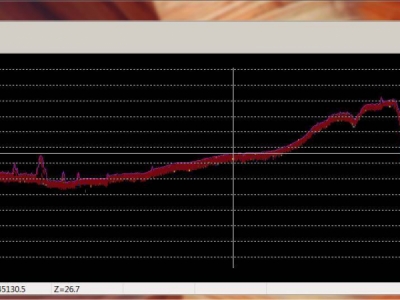
Posted on April 22, 2019
Ross Labs, LLC has upgraded its 825C single beam sounder to include Ethernet transmission of echograms — digitized analog data — to the HYPACK Single Beam Editor program.
“This feature allows the transfer of the echogram data to Hypack Survey in real-time so it can be displayed, time-synced and stored along with the other raw data collected during the survey,” said Duane Moloney, software manager at Ross Labs.
A dedicated computer on-board houses the Hypack program.
“The echogram is then accessed in Hypack Single Beam editor, where it is graphically overlaid on the raw sounding data. This gives the user additional characteristics of the soundings that will aid in editing them. Displaying the echogram in real-time allows the surveyor to better monitor the data coming into Hypack Survey,” he said.
The echogram feature requires that one GPS unit be interfaced to both the 825C and to Hypack, ensuring that the echogram is time tagged with the same time source used by Hypack.
Adding this feature required the addition of an Ethernet port to the 825C to allow the large amount of echogram data to be transmitted. This model previously had only a serial output and transmitted only the frequency of both channels and the digitized depth of each in both feet and meters to Hypack, Moloney explained. The output over the serial link is about 80 bytes per ping.
The 825C echogram link transmits about 1.5kByes per ping of data for each frequency at a typical depth range of 50 feet. In addition to the actual echogram, other information is sent to Hypack that the serial connection does not provide, including UTC time tag, draft, speed of sound and blanking depth.
The echogram data is dependent on the depth range the 825C is set in. The deeper the range the more data is sent to represent the entire water column. The sounder also sends a separate echogram for each of the frequencies, so in a dual frequency set there is twice as much data sent over the Ethernet connection.
The blanking depth is the depth above which the digitizing subsystem cannot look for an echo. This prevents the system from digitizing on its own transmit pulse, something that can typically happen on the long transmit pulse from some 28 kHz transducers. The blanking depth, along with the bottom following gate, can be used to hide aeration or fish in the water column. The 825C will display asterisks (***.*) if the digitizing algorithm calculates a depth that is at the blanking depth. This indicates that the blanking depth should be lowered.
“We can upgrade some of the newer 825Cs by adding an Ethernet port and installing the updated software,” Moloney said.
“We added the feature at the request of the Panama City, Florida Corps via Joe Burnett of Hypack,” Moloney said. Hypack programmers created the drivers in the Survey and Single Beam editing programs that interface with the 825C sounder.
“We installed the new software on the Corps units in November of last year. Every new 825C Ross has sold since the first of the year has the new software and Ethernet connection installed,” said Moloney, adding that Ross is in the process of upgrading an existing 825C for a client by adding the Ethernet port and installing the software.
Previously, the only data sent to Hypack were the digitized depths for both frequencies in a custom NMEA type sentence, via a serial port interface. The 825C is also capable of sending the standard NMEA sentences $SDDBT and $SDDPT, Moloney explained. This functionality still exists in the updated software, and the user can choose to send data either by echogram or by the serial port sentence.

The Ross Model 825C was designed for small open boats requiring precision depth data input for customers using just a Hypack computer, a GPS receiver and the sounder. It incorporates a bright full-color sunlight readable display and the latest computer processors running a Windows-driven drop-down menu system. The echogram interface provides a new tool for the surveyor, giving the operator much more information about the bottom signal and quality of the soundings. The transducer can be mounted on the side of the vessel or permanently mounted in the hull, with an option to run two different frequencies, typically 200kHz and 24kHz or 28kHz.
Ross Laboratories was acquired in 2014 by Teknologic, LLC and is now operated as Ross Labs, LLC. The companies share a facility located in Edmonds, Washington, with a manufacturing facility large enough to assemble both Ross and Teknologic sonar products, including the installation of sweep survey systems on 26-foot aluminum catamarans.
Teknologic has a history in sonar system design, signal processing, data acquisition and unmanned underwater vehicles.
Among the company’s products are acoustic receivers for the Juvenile Salmon Acoustic Telemetry System (JSATS). JSATS tracks individual juvenile salmon implanted with transmitters sending 16-bit fish identification codes. These systems have been deployed as autonomous and portable receivers, cabled arrays, and mobile and autonomous 3D tracking systems in support of the mission of improving salmon survivability.
The company has provided hundreds of rechargeable battery-powered and cabled sonar receivers for Washington and California dam and river censusing and 3D tracking.
Source: dredgemag.com





